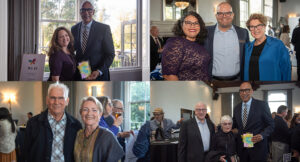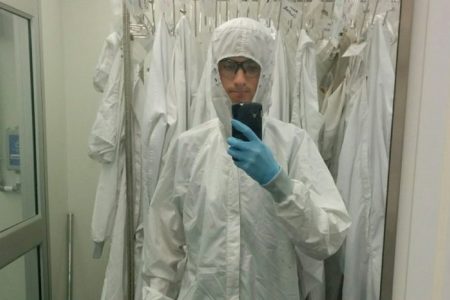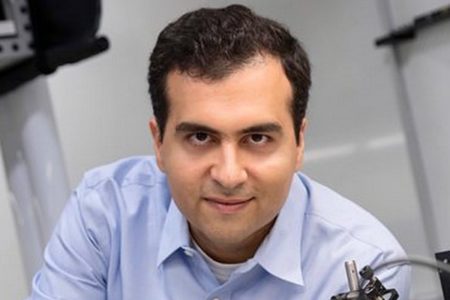
Mount Wilson Observatory Staff, circa 1917. [Credit- Mount Wilson Observatory] At bottom left, Jennie Lasby. At right, Louise Ware at center of group, wearing tie. [Bottom row photos courtesy of Dr. Eun-Joo Ahn]
Jennie Belle Lasby and Louise Ware were two such “human computers” whose fascinating work and scientific contributions will be the focus of a talk this Saturday at the Mount Wilson Observatory.
Dr. Eun-Joo Ahn, an astrophysicist and doctoral candidate, History of Science, at UC Santa Barbara will be telling the story of Jennie Belle Lasby, Louise Ware and other forgotten women scientists in the first decade of Mount Wilson Observatory – the work they did, the contributions they made, and the cultural and institutional terrain they faced.
Mount Wilson began hosting an observatory around 1889 and officially became the home of Carnegie Institution’s Mount Wilson Solar Observatory (MWO) in 1904. As expected during those times the astronomers were men, and the “human computers,” or at least many of them, were women. Their work was mostly “assistant” in nature.
Even when many women were graduating with astronomy degrees, some with PhDs, the working environment at MWO wasn’t very welcoming of women, and it was to be that way up to the 1960s.
“The playing field was extremely uneven between men and women scientists in the early 20th century,” Dr. Ahn said, “Women could train as scientists in college but the scope of their work after they graduated was highly restricted.”
Dr. Ahn’s talk would be focusing on Jennie Belle Lasby, who was the first woman research assistant at the Observatory, working as a human computer there from 1906 to 1915; and Louise Ware, who began work at the observatory in 1906. Between 1912 and 1922, Ware co-authored four further scientific publications with St. John on topics in solar astrophysics, from standardization of wavelengths and solar rotation.
“I chose the two because they were among the first women scientists hired at MWO who had a somewhat extensive written record or publications,” Dr. Ahn said.
Lasby was hired in October 1906; the third women scientist hired at MWO after Louise Ware and Ruth E. Smith.
“During her employment at MWO from 1906 to 1915, she mainly worked on spectroscopic measurements: first on solar work to study how the sun rotated through spectrographic measurement,” Dr Ahn wrote in a paper about the women scientists at MWO.
She worked mainly with Walter Adams, a partnership, although it was an unequal one. Despite major contributions, Lasby did not feature as a co-author in many of Adams’ works. But Adams did thank Lasby “for her most efficient performance of the exacting work involved in the measurement and reduction of the large number of plates.”
“Indeed, Lasby did not conform to the stereotype of a subordinate worker. About the time when the comprehensive report on solar rotation was published, she published a single-authored article on the same topic in Popular Astronomy, an astronomical journal whose readership was aimed at an audience who were less technically inclined and included amateur astronomers.”
“Lasby left unique footprints, she was the only woman employee at MWO who was an official member of the American Astronomical Society. and she was the only woman to use the 60-inch reflector until Margaret Harwood, director of the Maria Mitchell Observatory, observed in 1924,” wrote Dr. Ahn.
“She faced additional practical difficulties while staying up on the mountain.”
Louise Ware was the first woman scientist hired at MWO. In Pasadena, Ware’s first task was to obtain the heliographic positions of flocculi which required a combination of routine and skill. Flocculi behaved more like a fluid than a solid body, with their features constantly changing. Using her measurements and work, astronomer George Ellery Hale deduced how the sun rotated.
Louise Ware retired from Mount Wilson in August 1942 and was the fourth longest staff member of MWO. After retiring from the Observatory, Ware was involved in the war effort at Caltech until 1945 as a “computer in connection with rocket investigations.” She lived in Pasadena, passing away in 1953.
On Mount Wilson Observatory’s website can be found a photograph of staff taken in 1917 that showed many women who “undoubtedly served as low-paid “human computers,” the accompanying description reads.
“In this era, women, even highly-qualified individuals with college degrees, were relegated to the drudgery of making repetitive calculations or recording data extracted from glass plates taken by male astronomers,” the description continues. “Rarely was any credit given. Nevertheless, the discoveries of such famous ‘human computers’ as Henrietta Swan Leavitt and Annie Jump Cannon at Harvard were vital to the progress of astrophysics, and are now becoming better recognized.”
Another published article, on The Huntington Library’s website, goes into more detail on the role of human computers at the Observatory’s offices in Pasadena. To read it, visit www.huntington.org/verso/2015/09/women-computing-stars.
Guests at Saturday evening’s event at Mount Wilson can view the night sky until midnight through the Observatory’s 60-inch or 100-inch telescopes. The Los Angeles Astronomical Society will also have its telescopes set up around the grounds for viewing different night sky objects.
The Museum of Photon Technology on the ground floor of the 100-inch dome will be open for guests before they move up, in groups of 20, to the telescope level. This year, both the 60-inch and 100-inch telescopes will be open to lecture guests for observing until midnight.
Prior to the lecture, the Cosmic Cafe will be open until 5 p.m. Immediately after the talk, bring a picnic or purchase food provided by a food truck, and dine al fresco at the tables provided. Foor purchase will be by cash only.
For more information about Mount Wilson’s Saturday Evening Talks and Telescopes, visit www.mtwilson.edu/lectures.
Ahn, who recently wrote an article for the Mount Wilson Observatory titled “Women Scientists at Mount Wilson Observatory During the Early Years: Louise Ware and Jennie Belle Lasby,” will be discussing the role of women scientists there at the Saturday Evening Astronomy Talks and Telescopes series on Saturday, June 4, starting at 5:30 p.m.





